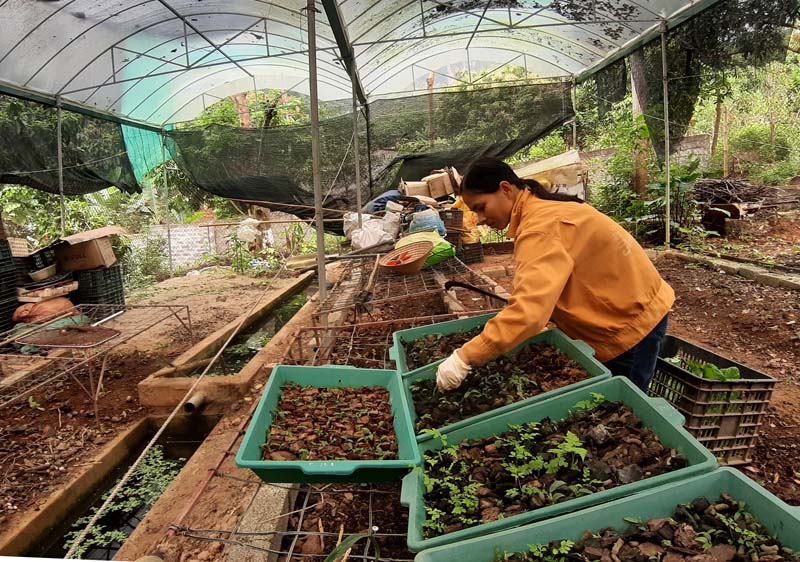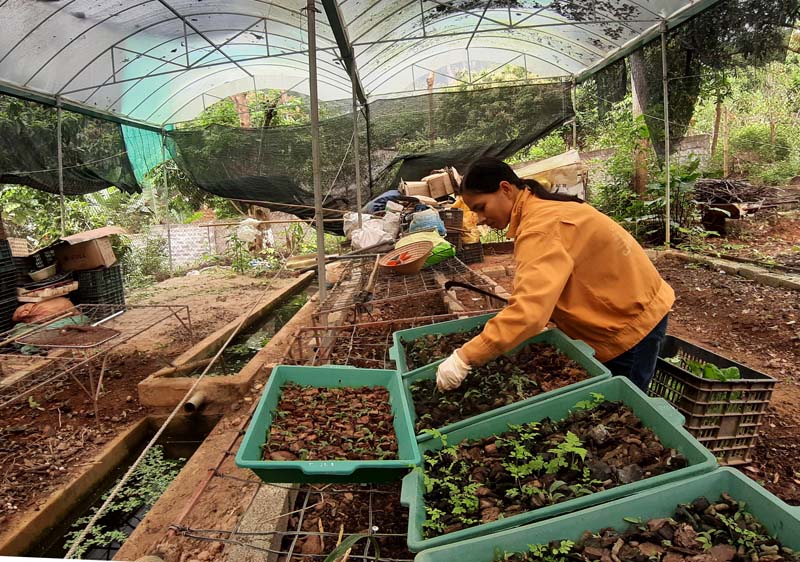
(HBO) – Hoa Binh province boasts relatively favourable natural conditions for growing medical herbs. Given this, a number of organisations and individuals have worked to develop large-scale medical herb farming zones, thus helping to provide jobs and raise income for locals.
 A
worker of the Biopharm Hoa Binh JSC examines medical herbs.
A
worker of the Biopharm Hoa Binh JSC examines medical herbs.
The Hoa Binh Medicine JSC, based in Hoa Son
commune of Luong Son district, specialises in growing, researching and
producing medical herbs, especially "xa den” (Celastrus hindsii Benth) which is
useful for health improvement. It carried out a scientific study which looked
into the chemical composition of the special herb and assessed the biological
activity of some compounds from this plant. The firm submitted its findings to
the authorised agency to seek a patent and is currently investing in a
production line. Some "xa den” derivatives have also been produced on a trial
basis.
Meanwhile, the INCA Vietnam JSC has coordinated
with relevant agencies and localities to create a sacha inchi growing area for
many years and reaped encouraging outcomes. Suiting the local mountainous
climate and soil conditions, the plant has developed well here and generated
relatively high economic benefits.
The growing area produced 1 – 1.3 tonnes of dry
fruit per ha in the first year and more than 3 tonnes since the third year,
with annual profit reaching 150 – 200 million VND (6,400 – 8,500 USD) per ha on
average.
INCA Vietnam said it plans to form a
concentrated sacha inchi farming zone in Hoa Binh and build a factory here to
process materials.
Via effective scientific research activities,
the Biopharm Hoa Binh JSC has successfully developed a cordyceps production
process and multiplied some available medical plants like ginseng, "thong dat”
(Palhinhaea cernua), "hoang tinh do” (Polygonatum kingianum Coll. et Hemsl.)
and "thong do” (Taxus wallichiana).
Hoa Binh boasts potential and advantages for
developing medical plant growing zones and producing medicines. In its plan on
developing medical herb farming areas until 2025, the province will focus on the
24 plants that it has strength in and cultivate them on over 2,800ha of land to
harvest about 14,000 – 20,000 tonnes of materials each year.
To that end, provincial authorities have been
assisting localities to convert ineffective farmland areas into those for
growing herbs in the long term, thus helping to improve the economic value on
the same farming area, create more jobs and raise income for locals, and
protect producers and consumers’ health and the environment.
Under the province’s instructions, localities in
Hoa Binh are reviewing areas zoned for herb farming, proposing support
policies, and inviting investment to medical herb cultivation and processing.
They are also building hi-tech production models, form connectivity between
producing and processing companies, and encouraging farmers to change crop
structures to develop concentrated medical herb growing zones./.
According to data from the Hoa Binh Provincial Party Committee, the industrial production index for the first six months of 2025 is estimated to have increased by 20% compared to the same period last year. This marks the highest year-on-year growth rate for this period since 2020.
In the first six months of 2025, Hoa Binh province’s export turnover was estimated at 1.145 billion USD, marking an 18.11% increase compared to the same period in 2024. Import turnover was estimated at $ 804 million, a 17.15% increase, which helped the province maintain a positive trade balance.
The lives of the ethnic minority farmers in Tan Lac district have gradually improved thanks to the new directions in agricultural production. This is a testament to the collective strength fostered through the professional associations and groups implemented by various levels of the district’s Farmers’ Union.
With the motto the "product quality comes first,” after nearly one year of establishment and operation, Muong village’s Clean Food Agricultural and Commercial Cooperative, located in Cau Hamlet, Hung Son Commune (Kim Boi district), has launched reputable, high-quality agricultural products to the market that are well-received by consumers. The products such as Muong village’s pork sausage, salt-cured chicken, and salt-cured pork hocks have gradually carved out a place in the market and they are on the path to obtaining the OCOP certification.
In the past, the phrase "bumper harvest, rock-bottom prices" was a familiar refrain for Vietnamese farmers engaged in fragmented, small-scale agriculture. But today, a new spirit is emerging across rural areas of Hoa Binh province - one of collaboration, organisation, and collective economic models that provide a stable foundation for production.
Maintaining growing area codes and packing facility codes in accordance with regulations is a mandatory requirement for agricultural products to be eligible for export. Recently, the Department of Agriculture and Environment of Hoa Binh province has intensified technical supervision of designated farming areas and packing facilities to safeguard the "green passport" that enables its products to access international markets.



 A
worker of the Biopharm Hoa Binh JSC examines medical herbs.
A
worker of the Biopharm Hoa Binh JSC examines medical herbs.